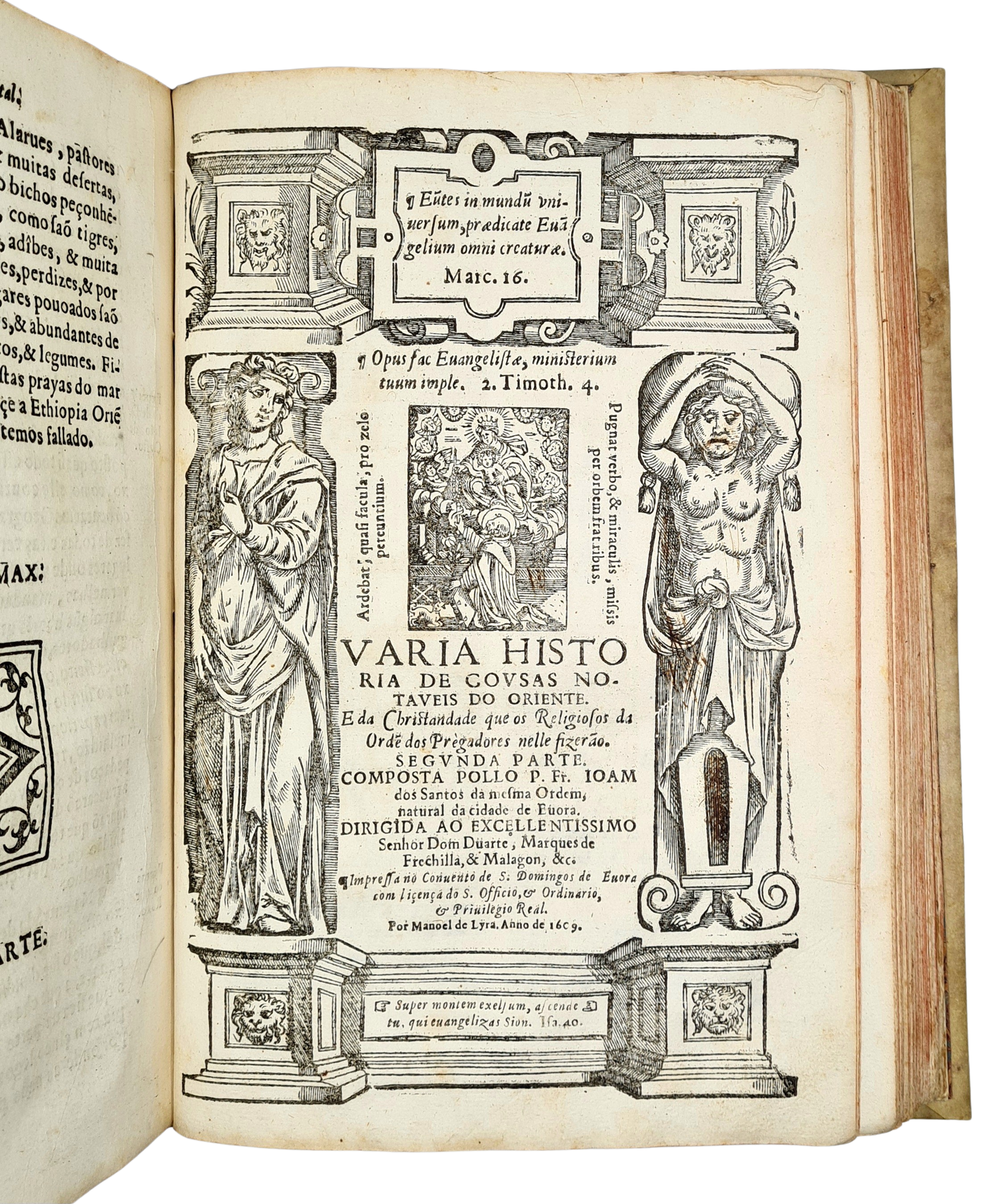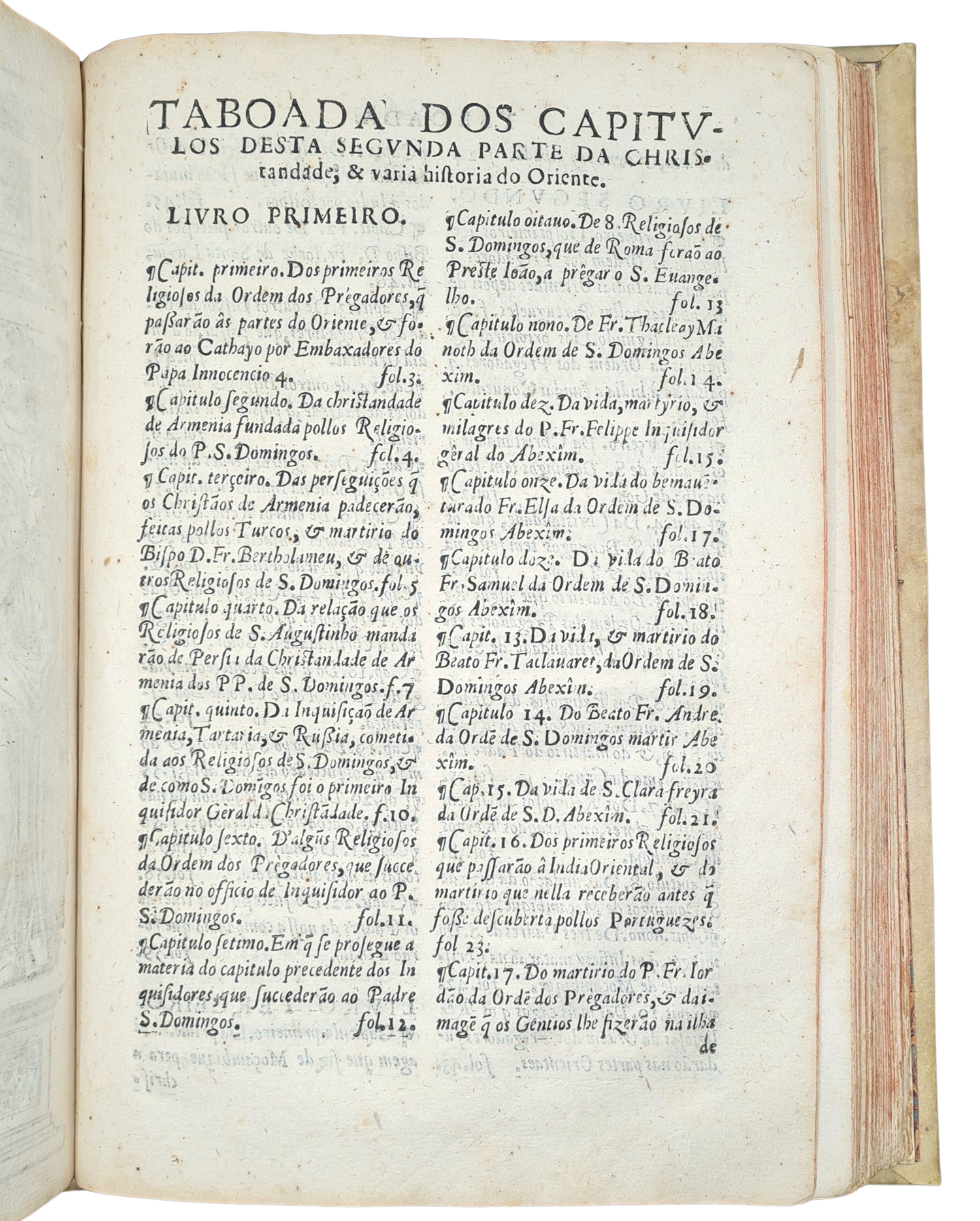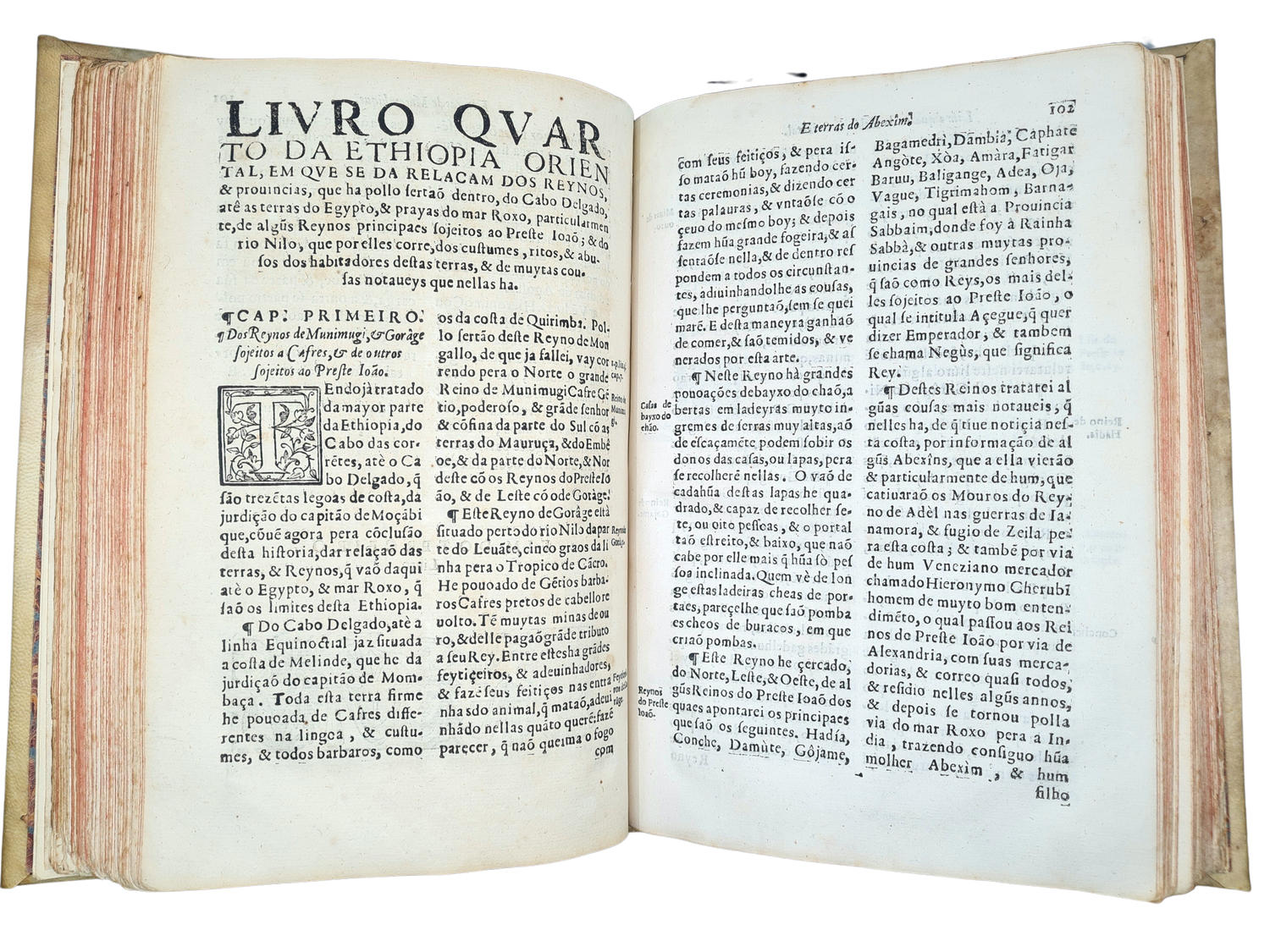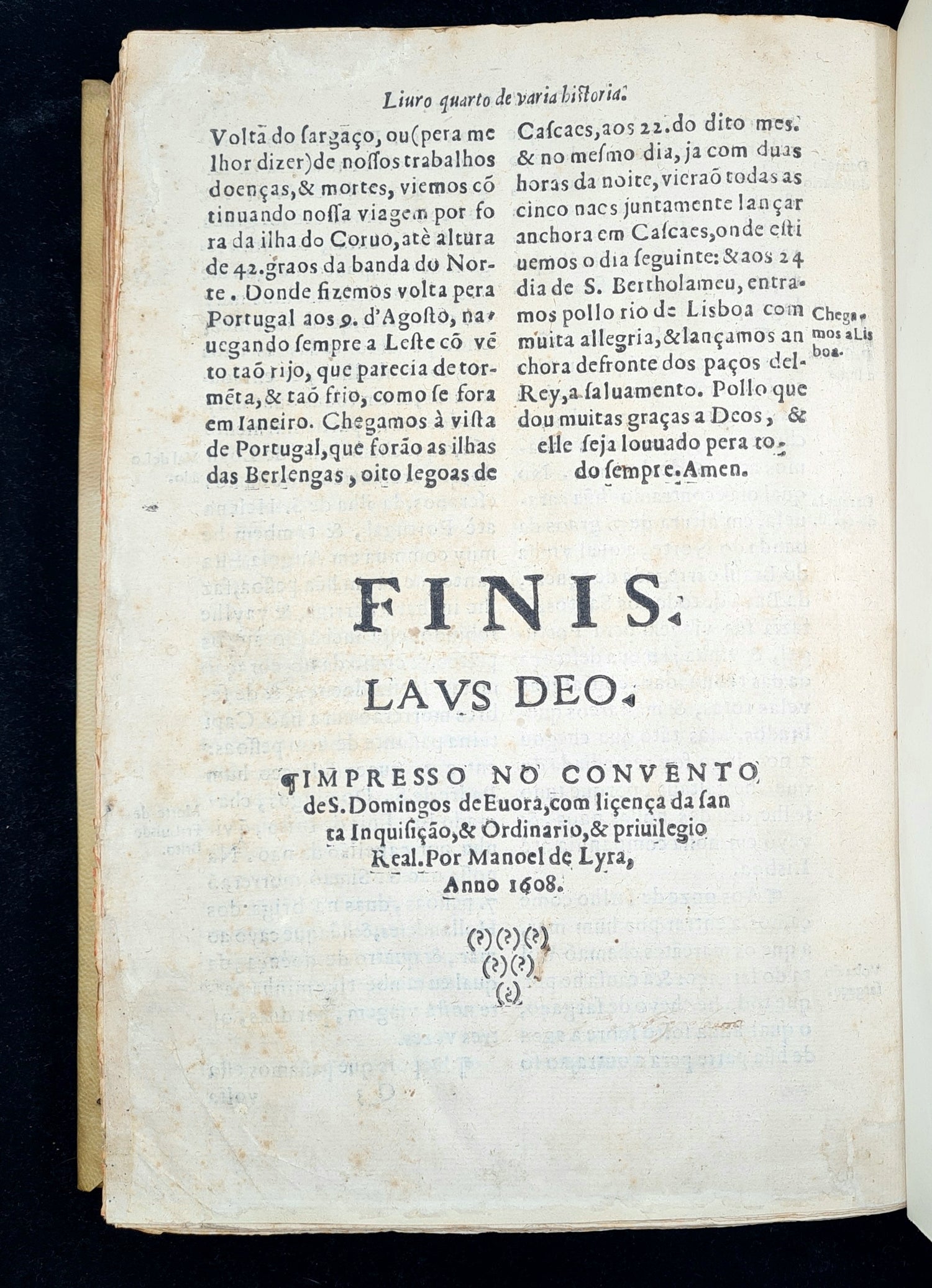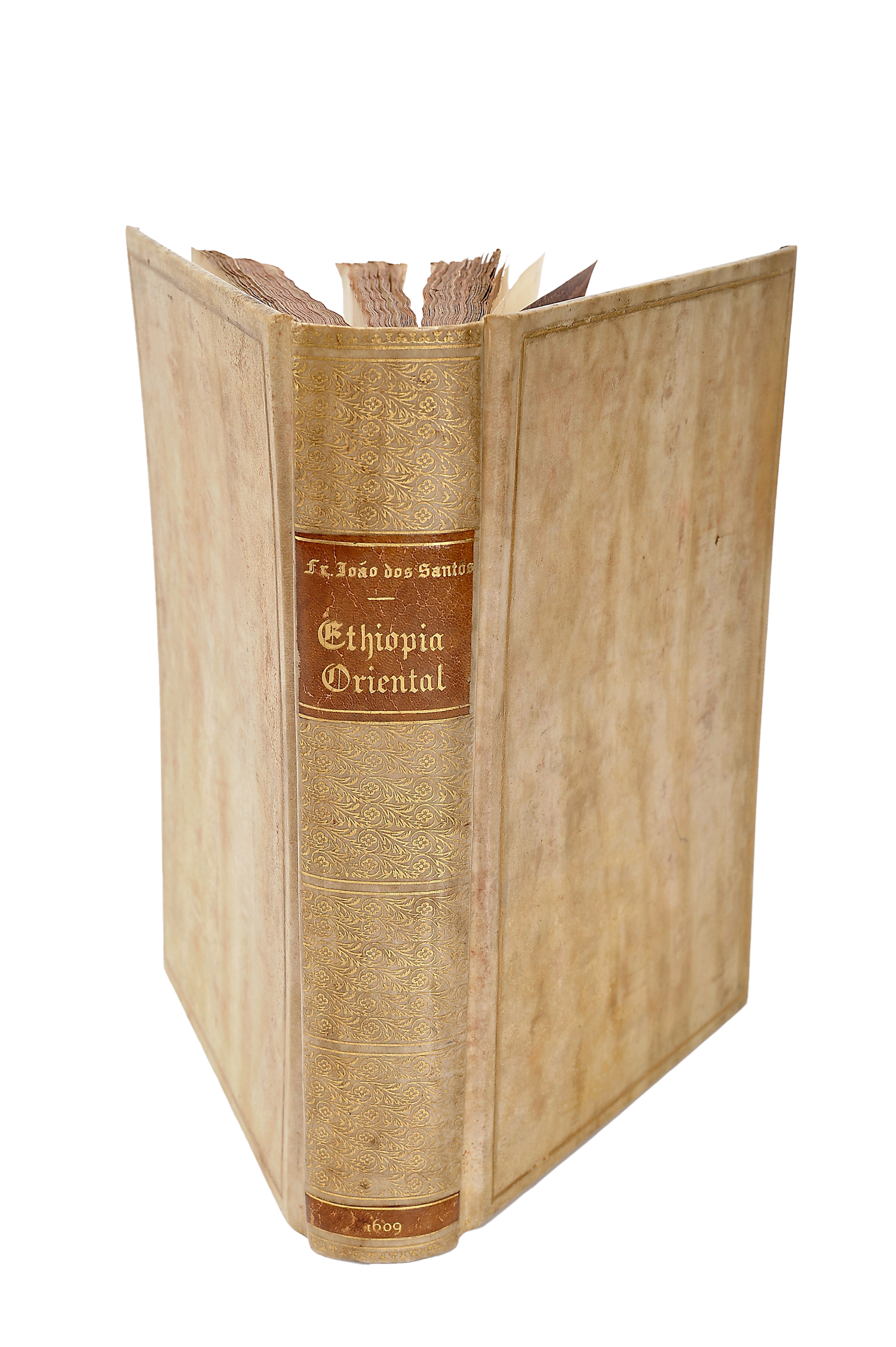Santos, Ethiopia Oriental, 1609.
- Regular price
- €24.500,00 EUR
- Regular price
-
- Sale price
- €24.500,00 EUR
- Unit price
- per
RESERVED
Extremely rare, important and early work on East Africa and the East Indies
João dos Santos (Évora after 1560 - Goa 1622).
Ethiopia Oriental e varia historia de cousas notaveis do Oriente.
[Including:]
Varia historia de cousas notaveis do Oriente. E da christandade que os religiosos da Ordem dos pregadores nelle fizerāo
Évora, (colophon vol. 2: Impresso no Convento de S. Domingos de Evora), Manoel de Lyra, 1609 (colophon vol. 2: printed in 1608).
2 volumes in 1. 8°. [8], 140; [3, 1 blank], 123 ll. (index bound after title in vol. 2). Collates: [pi]6, 2[pi]2, A-R8, S4; A, Q4-Q6 [= index], A2-A8, B-P8, Q3 (complete).
Vol. 1 with an engraved title-page depicting a female figure seated on a crocodile (dragon?), an elephant, a palm tree, a lion and a church in a landscape, surrounded by an architectural border with the image of Saint Dominic in a cartouche at the top. Signed Bras Nunes Fecit; vol. 2 with the title-page in a woodcut architectural border with two caryatids and an inset vignette with Saint Dominic and Madonna. Furthermore with several woodcut ornamental initials and head- and tailpieces.
Rebound in older stiff vellum with traces of medieval lettering, gold-tooled spine in early 20th century “à la grotesque” style, red painted edges.
Complete first edition of the first book on East Africa and its (Muslim) communities, followed by a vast collection of Dominican missionaries’ descriptions of Armenia, Turkey, Persia, Tartary, Russia, Abissinia (Ethiopia), India (a.o. Goa, Chaul, Cochi), Indonesia (a.o. Solòr & Timor), Siam, Cambodia, Mozambique, South Africa, Sao Thomé, Malaysia and Japan.
This remarkable book was already called “extremely rare” in a 1783 London auction catalogue and in the 1923 Gilhofer & Ranschburg catalogue. Today very few libraries own a copy. Outside Europe we traced only one in the U.S. (CUA), one in Toronto and an incomplete copy in Macau. Most copies, including Madrid, have a missing or heavily damaged frontispiece.
The first volume is an autobiographical narrative of an 11-year missionary journey from Portugal to East Africa and back by Dos Santos. The title, Ethiopia Orientalis, can be confusing because the book actually provides a description of the nature, customs, and history of what is now mainly Mozambique, the Comores and Madagascar. The book is regarded as “the best description of the Portuguese occupation of Africa at the end of the sixteenth century, when Portugal was at the zenith of her power there. His account of the manners and customs of the Bantu tribes at that date is most valuable (...) This work is now a Portuguese classic.” (see Theal). Furthermore, it is “The first European description of the customs of various African ethnic groups, including Swahili communities and other Muslim groups” (see Lobato). It provides the only remaining source for historic events that occurred in the region by the Swahili, Azimba, Tonga, Bororo, Makua, Mouros (for the whole Muslim population along the coast), Ottoman and Arab people. The entire first part of this volume deals with the Muslim communities in East Africa. Dos Santos admits in his book to aggressive acts by him and other Europeans against Islamic practises, such as the burning of a mosque and forbidding Ramadan ceremonies. But he also reports about the peaceful coexistence of Muslims and Christians. He shares much about the role of women in the tribes that he encountered. Slavery is a recurring theme in the book whenever Santos writes about Europeans, making this survey fundamental for our knowledge of the Portuguese slavery exploits in colonial East Africa. He also made valuable observations about the natural history of the region. In several chapters he describes “fruits and cereals, as well as descriptions of animals such as crocodiles, lions, leopards, wild dogs, monkeys and baboons” (see Beinart). Santos claims to have seen and even eaten a mermaid(!), that he calls “peixe mulher”. The book is also “the first Western text describing the torporific catfish” (see Piccolino), called “peixe tremendor” (tremble fish), found in Mozambique's Sofala River. Santos observed that local people used the skin of the fish for “fetishes”. Due to difficult access to the region, Ethiopia Oriental remained the primary source for information on East Africa until the mid-19th century (see Lobato), making its significance invaluable.
This is the only known published work by the Portuguese Dominican missionary João dos Santos. It consists of two bibliographically independent volumes that are always found together. It was published at the Dominic College in Évora, where Dos Santos had received his education and returned to in between his travels. With this important publication the Dominicans aimed to assert their position in East Africa and Asia against their Jesuit competitors.
Dos Santos left Portugal in 1586 and four months later he arrived at Ilha de Moçambique, a small island strategically located at the narrowest point of the Strait of Mazambique. It had a large fort that served as a slavery hub. The Dominicans had a monastery there. He was at once sent inland to Sofala, where he remained four years with Friar João Madeira. His goal was to convert the local Muslim population to Christianity. Between them they baptized some 1694 natives and had built three chapels when they were ordered back to Mozambique. After a journey of great hardships they were forced to remain on the Zambesi River, dos Santos staying at Tete for eight months. From registers found there he discovered that the Dominicans had baptized about 20,000 natives before the year 1591 at Tete alone. From Mozambique he was sent to the small island of Querimba, where he remained for two years. The registers here gave the information that 16,000 natives had been baptized before the year 1593. Next he was appointed commissary of the Bulla da Cruzada at Sofala, where he stayed more than a year. His labours in Africa ended on 22 August, 1597, when he left Mozambique for India where he stayed in Goa and Cochin. In 1600 he returned to Portugal, where he worked on the present book. He left again for Mozambique shortly after the publication of Ethiopia Oriental, in 1610 and from there he travelled to Goa where he lived the rest of his life until he died in 1622. In 1891 a second edition appeared, which is now mostly held in libraries worldwide, instead of the present first edition.
Whereas the first volume only concerns East Africa, the second volume, Varia Historia, has a broader scope. The 83 chapters delivering tales of Dominican missionaries from all kinds of faraway places east of Europe, providing a wealth of information on places and events in India (a.o. the conquest by the Mughals of Chaul and a report on the Muslim Kunjali people in Malabar), the Malay Archipelago, Russia and much more. This volume has consistently been understudied compared to the Ethiopia Oriental.
Condition: A good copy. Both illustrated title-pages with some retouches in ink. Mainly marginal restoration to the first title-page. Minor marginal thumbing and spotting. Otherwise in very good condition.
Provenance: Silva’s / Pedro de Azevedo auction, November 2000, lot 736.
Reference: Arouca, S 176, 177; Ávila Perez, 7001; Palau, 300592; Palha, 4222; Inocêncio, IV, p. 33; Salva II, 3400; Samodães (with facsimile title), 3056; not in Brunet and Heber.
Copies: BLC 290-47; CGBNP 162-1069; NS 0121640.
For illustrator Bras Nunes see: Ernesto de Sousa, 1374.
Literature:
Beinart, William, Saul Dubow. The Scientific Imagination in South Africa: 1700 to the Present, Cambridge University Press, 2021.
Gilhofer & Ranschburg catalogue nr. 163: Incunabula, standard works comprising rare and valuable books on bibliography, typography, geography, Africa, America, Balcans, Orient, Jesuits etc. Vienna, Verlag von Gilhofer & Ranschburg, 1923, nr. 407: “The extremely rare book. The first part unknown to Brunet and Heber, contains many important and interesting informations on Moçambique, Egypt, Arabia and India. The second part contains the history of Christian missions in this countries.”
Lobato, Manuel. “João dos Santos” in: D. Thomas & J. Chesworth (ed.), Christian-Muslim Relations. A Bibliographic History. Vol 9: Western and Southern Europe (1600-1700), Leiden, Brill, 2017, pp. 92-99.
Newitt, Malyn. A History of Mozambique, Indiana University Press, 1995.
Piccolino, Marco, Stanley Finger, Jean-Gaël Barbara. “Discovering the African Freshwater “Torpedo”: Legendary Ethiopia, Religious Controversies, and a Catfish Capable of Reanimating Dead Fish.” In: Journal of the History of the Neurosciences, Taylor & Francis (Routledge): STM, Behavioural Science and Public Health Titles, 2011.
Theal, George McCall. The Portuguese in South Africa, with a description of the native races between the river Zambesi and the Cape of Good Hope during the sixteenth century. Cape Town, J.C. Juta & Co., 1896.
Couldn't load pickup availability
Share

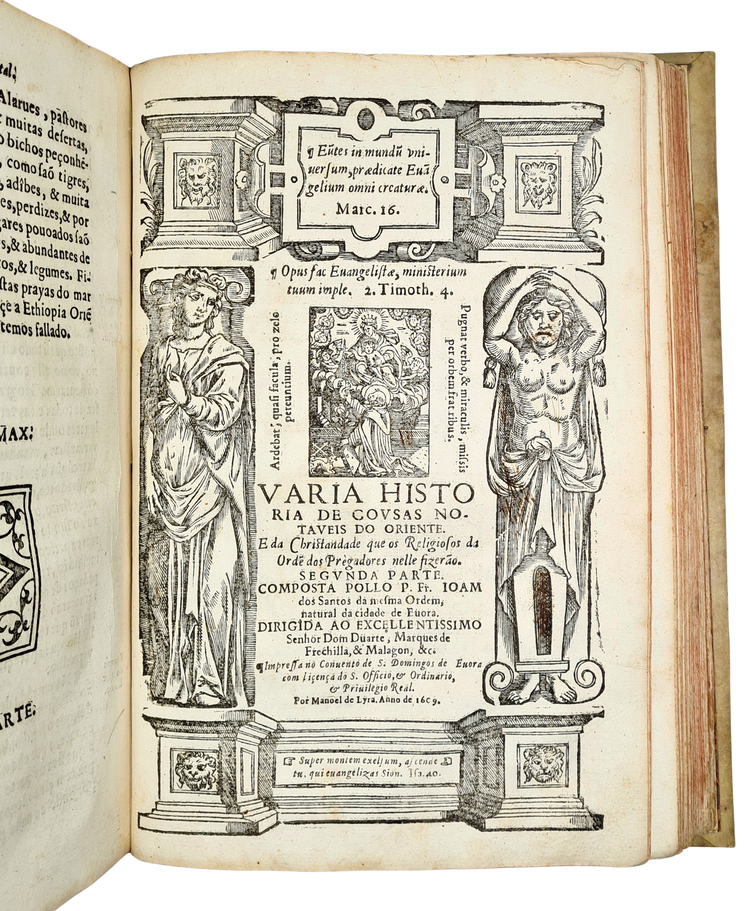

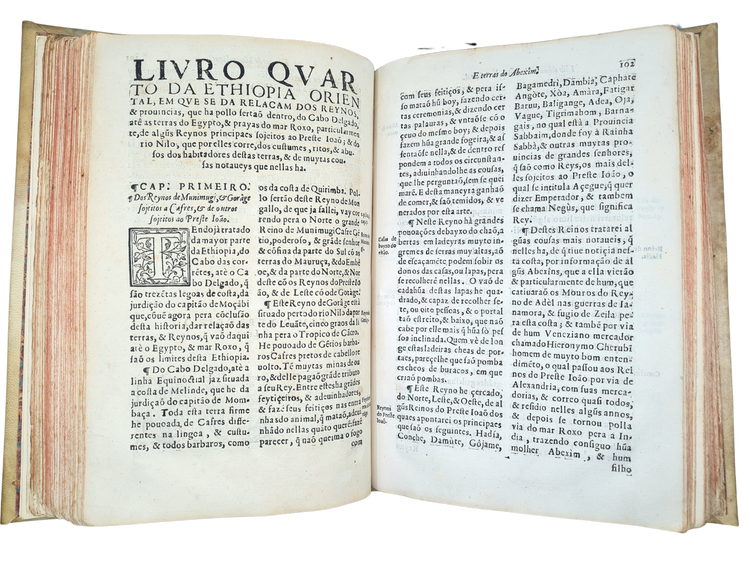

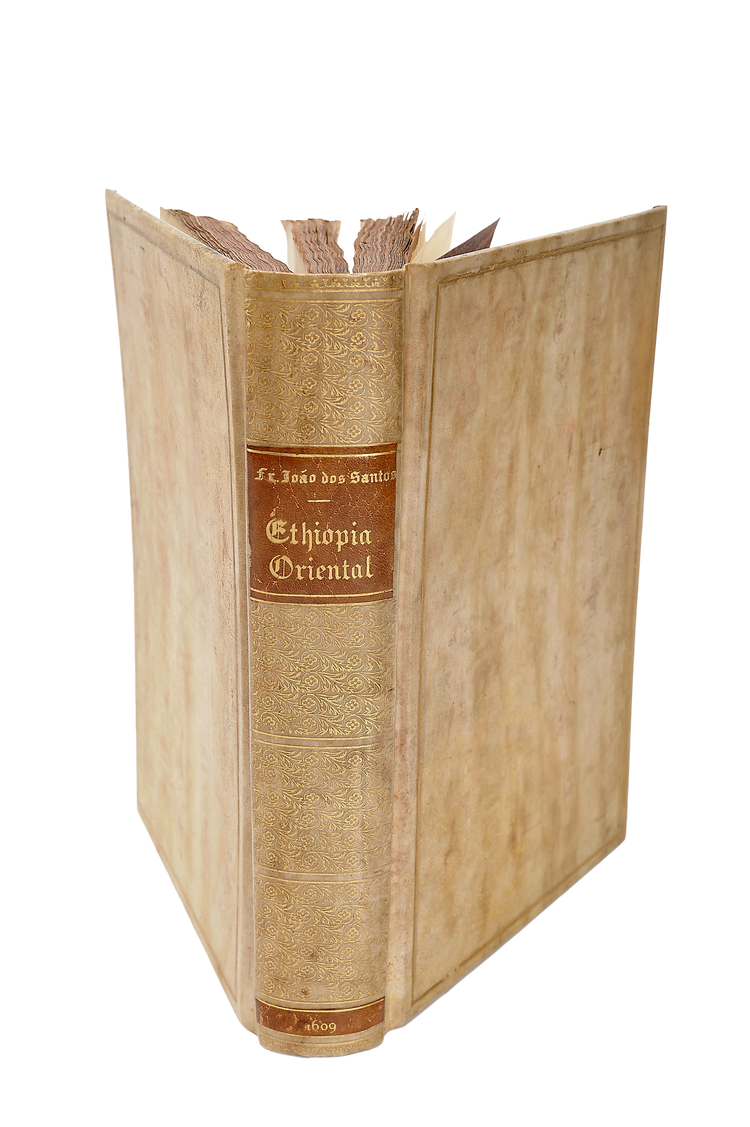
Contact
Email: hugo@artemrarebooks.com
Phone: +31651042297
Visit us on appointment at:
Former US Embassy
Lange Voorhout 102
2514EJ
The Hague (The Netherlands)
Shipping address:
Nannie van Wehlstraat 51
2548MN
The Hague
The Netherlands


